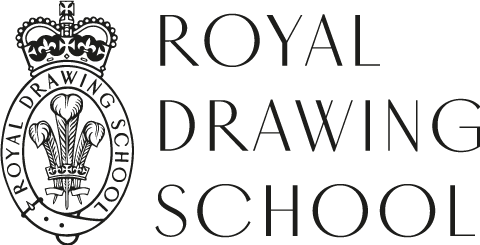Drawing from Home: The Point of Perspective
Taken from the recent publication by the Royal Drawing School, Ways of Drawing, The Point of Perspective, is an exercise designed by faculty member Martin Shortis that aims to help us understand perspective and vanishing points.

The Point of Perspective
Where: indoors, with a view of a built up area
With: 2 sheets of acetate or clear vinyl, tape, 3 or more fine, semi-permanent marker pens of different colours, a straight stick or ruler, ideally 1m
Perspective is a system that unites space. When we draw with perspective we are using objects to express space; space becomes the most important things and objects become secondary. This exercise will help you understand perspective and vanishing points, how to predict distortion and how vanishing points can be used to portray a particular perspective.
- Find a window (the larger the better) with a view of some buildings which you wish to draw. Choose a position where things recede away from you - avoid drawing the view head-on
- Attach a piece of acetate or clear vinyl to the window, or draw directly onto it. The architect Lutyens used small pieces of soap to draw on glass
- Position yourself close enough for your pen to touch the window. You will need to keep your head at the same 'viewpoint'; it can help to rest your chin or forehead on a piece of furniture
- Draw your view, paying particular attention to the orientation of physically horizontal lines. Attach the second sheet of acetate or vinyl over the finished drawing
- Drawing onto the second sheet, extend the lines to their vanishing points. To do this, you will need to extend the lines out so far that they cross over with other, parallel extended lines, i.e. the top and bottom lines of a window. This cross section is known as the 'vanishing point'. You should end up with numerous vanishing points - one for each set of parallel lines. Use different colours for different sets of lines to avoid confusion.

If the vanishing points are beyond the edge of the sheet and window, you might need to extend the lines onto the wall. If so, try using pins connected with string, or take the drawing and place it on a larger sheet of paper - you can stick several sheets together if required. Notice where groups of parallel lines meet. Hopefully, you will find that all the vanishing points end up at the same level - which should be the same as your eye level.

This exercise demonstrates that a vanishing point is not something real, but is created by our viewpoint. Vanishing points position the view and their particular perspective as opposed to a generalised view.
You many need to try this several times to make it work. Keep practising and don't worry if your drawing is 'bad'. This exercise will help you to see and think about space in the build world, and to develop your spatial imagination.
Tag us in your drawings on instagram @royaldrawingschool or Twitter @RoyalDrawing and use the hashtag #drawingfromhome so we can share your creations!
In addition to teaching at the Royal Drawing School, Martin Shortis is also Head of the Print Room. He studied at the Ruskin and RA Schools, where he concentrated on making large commissioned drawings working on the spot. He has taught since 1992 and continues to draw outside and around London.
Drawings from top: Michael Chance, Martin Shortis



